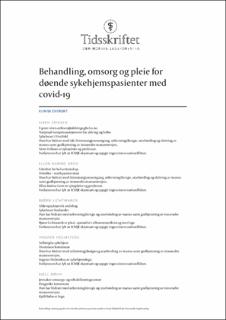Behandling, omsorg og pleie for døende sykehjemspasienter med covid-19
Eriksen, Siren; Grov, Ellen Karine; Lichtwarck, Bjørn; Holmefoss, Ingunn; Bøhn, Kjell; Myrstad, Christian; Selbæk, Geir; Husebø, Bettina
Journal article, Peer reviewed
Published version

View/
Date
2020-04-23Metadata
Show full item recordCollections
Abstract
Skrøpelige eldre med multisykdom har høy risiko for alvorlig sykdom og død ved smitte med koronavirus. Til forskjell fra «vanlig død» på sykehjem der det er tid til forberedelser, kan tilstanden endre seg raskt og gi organsvikt. I denne artikkelen beskriver vi lindrende ikke-invasive og invasive tiltak for skrøpelige eldre på sykehjem som er døende på grunn av covid-19.
Covid-19 (sars-CoV-2) kan smitte og føre til infeksjon hos alle aldersgrupper i befolkningen, men skrøpelige eldre med multisykdom er sårbare og har høy risiko for alvorlig sykdom og død (1–3). Tall fra Norge så langt viser at gjennomsnittsalderen for dem som dør av sykdommen, er 84 år (Folkehelseinstituttet 14.4.2020). Wang og medarbeidere fremhever at sykdomsforløpet hos eldre over 70 år utvikler seg raskere enn hos andre aldersgrupper (3). De fleste eldre som får påvist koronasmitte, blir imidlertid friske. For eldre over 80 år viser tall fra Italia en dødelighet på 20,2 % og fra Kina 21,9 % (3, 4). For personer eldre enn 90 år er en dødelighet på 22,7 % observert i Italia (5). En studie fra USA fant at 33,7 % av covid-19-smittede sykehjemsbeboere døde av sykdommen (2).
De aller fleste som bor på norske sykehjem er skrøpelige, sårbare og multisyke. Mer enn 80 % har demens (6). Koronaviruspandemien skaper store utfordringer for helsesystemet og for helsepersonell, og det reises mange omfattende etiske spørsmål og dilemmaer (7). Norske helsemyndigheter anbefaler at pasienter på sykehjem som blir syke av covid-19, bør behandles i sykehjemmet og ikke legges inn i sykehus med mindre det finnes «særlig tungtveiende grunnerfor at innleggelse i sykehus åpenbart vil forlenge livet vesentlig og gi økt livskvalitet» (8).
Helsedirektoratet fremhever videre at personer med alvorlig sykdom i livets sluttfase må sikres god lindrende behandling og omsorg som ivaretar verdigheten både til pasienten og de pårørende (8). I denne artikkelen vil vi beskrive ikke-invasive og invasive tiltak for skrøpelige eldre på sykehjem som er døende på grunn av covid-19. Artikkelen bygger på retningslinjer, klinisk erfaring og fag- og forskningslitteratur. Frail elderly patients with multimorbidity are at high risk of serious illness and death in cases of corona virus infection. Unlike ‘normal deaths’ in nursing homes with time to prepare, the condition can change rapidly and cause organ failure. In this article we describe palliative non-invasive and invasive interventions for frail elderly patients in nursing homes who are dying due to COVID-19.
COVID-19 (SARS-CoV-2) is communicable and may cause infections in all age groups of the population, but frail, elderly and multimorbid patients are vulnerable and at high risk of serious illness and death (1–3). Data from Norway show that the average age of those who die from the disease is 84 years (Norwegian Institute of Public Health, 14 April 2020). Wang and colleagues highlight that in people over 70 years of age, the course of illness develops faster than in other age groups (3). However, most of the older people in whom a coronavirus infection is detected recover. For people over 80 years of age, figures from Italy indicate a mortality rate of 20.2 %, and from China 21.9 % (3, 4). Among people over 90 years of age, a mortality rate of 22.7 % has been observed in Italy (5). A study from the United States found that 33.7 % of nursing home residents infected with COVID-19 died from the disease (2).
The vast majority of Norwegian nursing home residents are frail, vulnerable and multimorbid. More than 80 % of them have dementia (6). The coronavirus pandemic gives rise to major challenges for the healthcare system and healthcare personnel, as well as to a number of ethical issues and dilemmas (7). Norwegian health authorities recommend that nursing home residents who fall ill with COVID-19 be treated in the nursing home and not admitted to hospital unless there are ‘strong reasons to believe that hospitalisation will clearly help prolong life and give improved quality of life’ (8).
Furthermore, the Norwegian Directorate of Health underscores that persons with serious illness at the end of life must be provided with appropriate palliative treatment and care that maintain the dignity of the patients and their families (8). In this article we will describe non-invasive and invasive interventions for frail and elderly nursing home patients who are dying from COVID-19. The article is based on guidelines, clinical experience and research literature.
